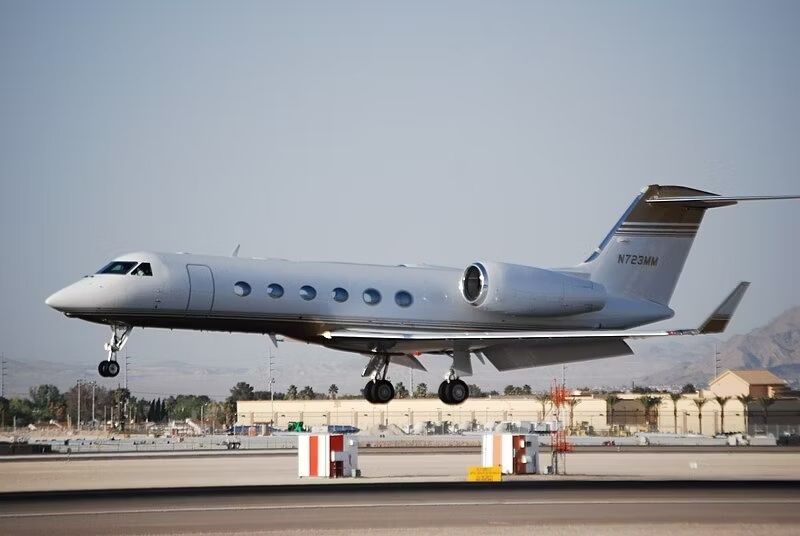The US-based private jet manufacturer Gulfstream
has long been known for a history of designing high-quality business jets, which can almost always be identified by their large, rear-mounted engines and trademark circular windows. One of the company’s most notable commercial successes is the Gulfstream IV family, a series of twinjet aircraft primarily built by the manufacturer at its Savannah, Georgia, headquarters between 1985 and 2018.
Gulfstream, which is in and of itself a subsidiary of the General Dynamics corporation, managed to sell over 900 Gulfstream IV family business jets, all of which were powered by a pair of Rolls-Royce RB.183 Tay turbofan engines. The final deliveries from this popular family were made in 2018, bringing to an end a nearly 30-year production run that saw planes enter service with private and corporate operators across the globe. Many of these jets also entered service with the United States Armed Forces, as well as other federal agencies like the National Oceanic and Atmospheric Administration.
Many different variants of Gulfstream IV family jets were released over the years, all of which found different levels of commercial success in the market. These included all the following:
While hundreds of examples across these variants were manufactured, one stands out as a sore thumb on the company’s order book. The Gulfstream G350, a shorter-range production version of the G450, was certified in 2004. However, the company only managed to sell 11 examples of this plane, according to Guardian Jet. Let’s take a deeper look at why the G350 failed to become popular with private operators.
The variant was designed to serve a unique purpose
The Gulfstream IV family was born in March 1983, when the company began to work in collaboration with Grumman to build a larger version of the popular Gulfstream III. According to FAA documents, the aircraft made its maiden flight on September 19th, 1985, and would later receive type certification on April 22nd, 1987. The original nomenclature for the Gulfstream IV was GIV-SP, but the plane would later be redesignated as the G400.
In 2002, a shorter-range version of the model was introduced as the G300. Soon after, an upgraded version of the G400, the G450, would hit the market with a lengthened fuselage and a larger cockpit. This new, advanced aircraft boasted liquid crystal displays and robust avionics.
Launch of a newer, more cost-effective variant
Gulfstream would later launch the G300’s replacement, the G350, at the National Business Aviation Association (NBAA) convention in Orlando in 2002, as per reports from Flight Global. The company’s president, Bryan Moss, would later go on to note at a separate event that the plane would better allow Gulfstream to compete with competitor offerings like the Dassault Falcon 2000EX and the Bombardier Challenger 604.
Certification, price, and specifications
This plane would offer the longer fuselage and dynamic engines of the G400 while offering a larger cockpit found on bigger Gulfstream jets like the G500 and G550, all for the relatively low price tag of $27.5 million. Now, Gulfstream believed that it would be in a strong position to compete in the large-cabin, mid-range aircraft segment. The aircraft was type-certified just a few years later, and the production variant would offer the following specifications:
|
Category: |
Gulfstream G350 Specification: |
|---|---|
|
Capacity |
19 |
|
Maximum Takeoff Weight (MTOW): |
70,900 lbs |
|
Maximum Speed: |
581 miles per hour (Mach 0.88) |
|
Range: |
3,800 nautical miles |
|
Service ceiling: |
45,000 feet |
In comparison to its older brother, the G450, the G350 offered only marginal improvements. The aircraft’s primary appeal is that it is a large-cabin business jet with a cross-country range that comes with a pretty modest price tag. With all the bells and whistles of a modern corporate jet for nearly 20 passengers, it is unsurprising that many expected the plane to be a commercial success. The plane would soon enter service, including with operators like the Mexican National Police.
So what went wrong?
At the end of the day, the G350’s primary flaw was failing to offer more significant improvements over its older sibling. Despite costing just $5 million less, the aircraft’s maximum takeoff weight (MTOW) was about 3,000 pounds lighter, and its range is a full 550 nautical miles less, which can make a difference when it comes to transoceanic travel. All of this led Business Jet Traveler to conclude as follows back in 2009:
“From the outside, the $32 million G350 and $37 million G450 are almost indistinguishable. The sole external visual cue is the small window on the G450’s nose. It covers the infrared camera lens of that airplane’s standard infrared enhanced-vision system (EVS), which helps pilots identify runways, taxiways, and surrounding terrain sooner when they’re flying instrument approaches in limited visibility.”
The magazine would go on to note that both of these features, which were included on the G450, came as optional upgrades to the G350. Additionally, the aircraft’s cabin was not determined to be any more luxurious than its older brother’s. As a result, most customers did not see the value in purchasing the slightly cheaper aircraft which lacked some of the fundamental capabilities most desired by private jet operators.
As a result, the carrier only ever built 11 examples of the type, despite selling over 900 airframes across the Gulfstream IV family’s many variants. It is unsurprising that, given this poor performance, the aircraft was quickly designated for “limited production,” and you would be lucky to spot one of the rare examples at an airport somewhere today.


